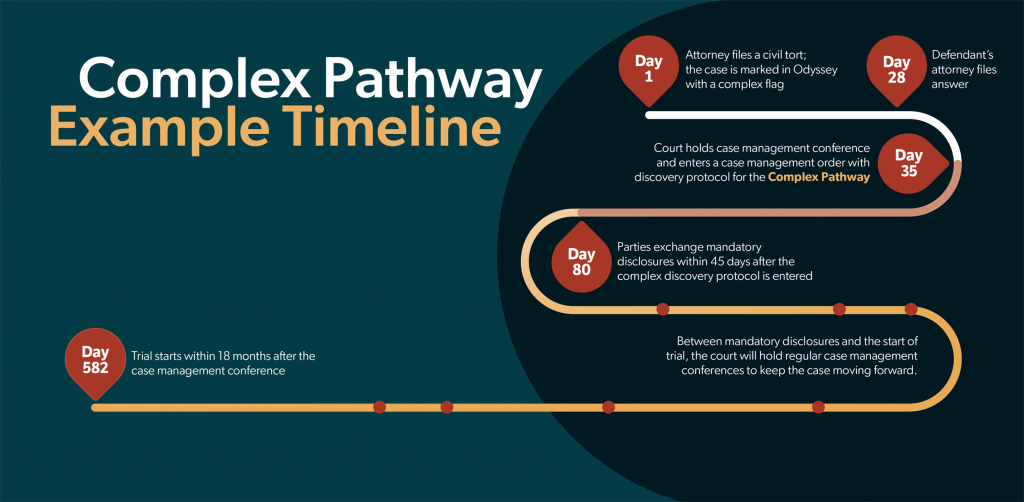By Amanda Wishin, Research Attorney • Office of Court Services, Legal Support Division
Based on a recommendation from the Civil Litigation Taskforce, the Civil Case Management Pathways Pilot Project was established by Supreme Court order and began on June 1, 2023, for a 2-year period.
Why pathways?
The Civil Litigation Taskforce’s Final Report recommended a civil case management pilot using pathways based on case types. Pathways allow courts to achieve right-sized case management to best align court management practices and resources.
This decreases the amount of time until case disposition, significantly reduces discovery disputes, allows judges to spend more time on complicated issues, and increases the satisfaction of court users. The pilot will allow time to finetune the model before it becomes available to other courts.
Pilot judges
Judges from both large and small counties are included in the pilot to test how this works for judicial officers with general and mixed dockets.
Jon Brown
Hamilton Superior 2
Jennifer DeGroote
Allen Superior Court 3
Kimberly Dowling
Delaware Circuit 2
Mark Dudley
Madison Circuit 6
William Hughes
Hamilton Superior 3
Hunter Reece
Warren Circuit
Richard Stalbrink, Jr.
LaPorte Superior 2
The breakdown
The pathways are presumptively assigned by case type in Odyssey. Either the parties or the judge can move a case to a different pathway as needed.
Streamlined Pathway
- CC – Civil Collection
- EV – Petition for Eviction
- MF – Mortgage Foreclosure
- MI – Miscellaneous
- TP – Verified Petition for Issuance of a Tax Deed
- TS – Application for Judgment in a Tax Sale
Complex Pathway
- CT – Civil Tort
- CP – Civil Plenary
General Pathway
A third pathway, the General Pathway is for those cases that have characteristics that make them unsuitable for their presumptive Streamlined or Complex Pathway. These cases fall somewhere in the middle.

Right-sized case management
To achieve right-sized case management, the pilot judges set early case management conferences where a case management order and discovery protocol are entered for Complex and General Pathway cases. Case management order forms and discovery protocols are available for the judges in Odyssey and for the attorneys on the Supreme Court’s website. A detailed electronically-stored information (ESI) protocol is also available.
To ensure that cases stay on track, firm trial dates are set from the date of the case management conference: 6 months for Streamlined Pathway cases, 12 months for General Pathway cases, and 18 months for Complex Pathway cases.
Limiting discovery
In attempting to keep costs proportional to the complexity and value of the case, discovery is tied to the pathway assigned. Each pathway has mandatory disclosures, limits on the number of written discovery requests, and limits on the number and length of depositions. Non-party discovery has no proposed limits, but a judge can add or approve limits in the discovery protocol.
Parties can agree to other limits in an agreed discovery protocol or request relief from the limits by filing a motion with the judge showing that the additional discovery is proportional to the needs of the case.
The pilot judges also have a few tools in their toolbox to limit discovery disputes:
- The pilot sets the relevant time period for all discovery to a period of 6 years prior to the date of the adverse event/action that forms the basis of the claim/counterclaim or defense.
- Any general objections to discovery are struck.
- When a dispute arises, parties must either meet in person, virtually, or by phone; email discussion is insufficient to satisfy Trial Rule 26(F).
- If parties are unable to agree after a meeting in person or by phone, parties must then ask for a short virtual or telephonic meeting with the judge to try to resolve the dispute before filing a written motion.
Forms
Order forms for the judges are available in Odyssey. The attorney forms are available online:
- Agreed Complex Pathway Proposed Case Management Order
- Agreed General Pathway Proposed Case Management Order
- Stipulated discovery protocol with ESI
- Stipulated discovery protocol without ESI
- Motion to change pathway